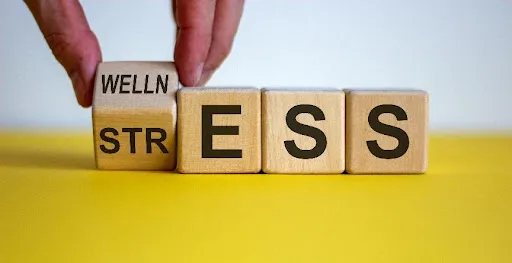Managing Stress with Physical Therapy: A Conversation with Doctor of Physical Therapy Heather Bitgood of Anodyne Anchorage, Alaska

As we cope with a perpetual cycle of crises and uncertainties, stress feels especially persistent and pervasive in today’s world. As noted in Anodyne’s article “Taking Stock of Stress this National Stress Awareness Month,” Gallup’s 2021 Global Emotions Report shared that, in 2020, stress levels reached unprecedented levels worldwide—with nearly 190 million people experiencing significantly higher stress levels than in years past. This stress wreaks havoc on our body—triggering symptoms ranging from insomnia and irritability to aches and pains to cardiovascular and digestive issues.
Increasingly, research is finding that physical therapy can do wonders to mitigate the symptoms of stress—including but not limited to relieving muscle tension and back and neck pain. To learn more about how physical therapy helps manage stress, we sat down with Doctor of Physical Therapy Heather Bitgood from Anodyne’s Anchorage, Alaska clinic.
How did you first become involved in the field of physical therapy?
I first learned about physical therapy and this career field when I was in high school and went to see a physical therapist for rotator cuff and elbow tendinitis (caused by overuse from throwing and hitting during softball and volleyball). Not only was the physical therapist able to get me back on the field without missing part of the season (which, as a young athlete, was very important to me), but the therapist also taught me how, by moving more effectively and efficiently, I could reduce pain and strengthen my shoulder.
Athletics always have been a part of my life, and working in physical therapy gives me the opportunity to utilize exercise and sport every day in my career. While in undergraduate and graduate school, my experience working as a strength and conditioning coach, training athletes of all ages and sports, solidified my desire to finish my graduate degree and become a physical therapist. Following PT school, I was fortunate enough to work as a traveling physical therapist for almost five years; I traveled throughout the western United States and Alaska, working at various settings with a variety of patients. My experiences as a traveler helped mold me into the therapist I am today.
Over the past years, what changes have you seen in the application of physical therapy?
Over the past few years, physical therapy—and healthcare for that matter—has changed dramatically. Working in various states and cities across the western United States showed me just how important exercise and activity are to our overall health—both mentally and physically—regardless of age.
In the physical therapy field, we’re seeing the profound impact that technology use is having on patients’ activity levels, posture, and core strength. Technology is having the most alarming effects on children and young adults, who are more tied to tablets, phones, TVs, and video games—now more than ever. As a result, we’re seeing worse and worse posture, with poor core control, due to sitting hunched over frequently or looking up or down at a screen for prolonged periods of time. Time spent on these technology devices also is taking a major toll on activity levels.
The Covid-19 pandemic also has contributed to the dramatic decline in regular exercise. Shutdowns and closures forced everyone indoors for long periods of time (which, in turn, encouraged device use) and school-aged kids didn’t have access to school gym classes, sports, or after-school activities—which, for some, were their only opportunities to be active. More than ever, we’re seeing how important it is to inspire and educate adults—role models like parents and grandparents—with the knowledge that exercise and activity are vital for the health of both our mind and body.
How are you seeing stress manifests itself in your patients?

I believe stress and anxiety levels are at an all-time high across different age groups of patients—with the dramatic societal and cultural changes of these past two years impacting mental health. Stress often presents itself in patients as poor sleep, poor diet and eating habits (including stress eating or, in some cases, absence of eating due to cultural norms), increased pain (especially in those with chronic pain), increased reliance on narcotics and other drugs used to combat pain and anxiety, as well as a decrease in overall motivation.
Exercise can assist with these—including helping to provide better sleep, improved confidence, improved body image, improved digestion, and the release of an abundance of feel-good hormones, which naturally help reduce stress and anxiety. Exercise allows us to tap into and harness all of the good our bodies have to offer both physically and mentally—and physical therapists are on the frontlines educating patients how to do this.
How are you using physical therapy to address stress-triggered conditions?
I think that the most effective thing a physical therapist can do is to not only teach and aide a patient in movement, but also to demonstrate for that patient all that they are capable of—regardless of age or condition. Physical therapists may be the conductors, but the patients are the musicians—and life is their concert. Time and time again, patients share, “I didn’t know I could do that!” or “I couldn’t do that before!”
How exactly do physical therapy methods relieve the symptoms of stress?

Exercise and activity release our natural feel-good hormones. Within minutes of performing activity, these hormones can reduce blood pressure, reduce heart rate, allow for improved breathing, reduce stress and anxiety, reduce depression, and allow a patient to feel empowered and in control—things a patient with chronic pain may seldom feel. Tapping into our bodies’ natural remedies is often difficult and challenging for patients, but with proper education in deep breathing techniques, core and postural training, and with a demonstration of new and safe ways to effectively exercise and move their bodies, patients can harness all of the positive energy offered within, and in turn, reap the benefits.
What steps can we take at home to help alleviate stress-induced pains and aches?
An easy, effective technique that doesn’t require any equipment is deep breathing. I recommend taking ten to fifteen long, deep belly breaths a few times each day. Deep breathing can quickly and dramatically reduce blood pressure, heart rate, stress, and anxiety.
Proper hydration, sleep, and exercise are also important in reducing stress. We should aim to drink ½ of our body weight in ounces each day (for example, a 180-pound patient should be drinking 90 ounces of water each day). In addition, the other topic I discuss often with patients affected by stress is the importance of a regular sleep schedule. Going to bed and waking up at the same time each day is very beneficial to our natural circadian rhythm.
Finally, and most importantly, it’s important to move—get outside, walk, stretch, play a sport, join a class, learn a new hobby or task, but whatever it is make sure it makes you move. We should aim to move and be active 20-30 minutes five days per week.
If you aren’t sure what activities you should do or can do, this is a great opportunity to meet with a physical therapist. A physical therapist can tailor an exercise and activity program specifically for you. Our goal is to not only help people reduce their pain, but also to get people moving again, and to be excited about moving and staying active. There are endless activities and exercises out there; sometimes, it just takes a little guidance to find the right one for you, and this is where we physical therapists shine.
To learn more about Anodyne Pain & Wellness Solutions’ physical therapy services as well as our clinics’ collaborative and comprehensive approach to patient care visit https://anodynepain.com/ today.
Related Articles
Whether you’re struggling to diagnose a chronic pain condition or you’re pursuing wellness treatments to stay healthy and feel great, we’re here to support you at every step of your health care journey.


